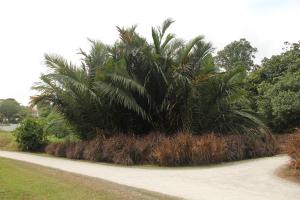Five Things to Look Out For in the Learning Forest

Looking for something to do this weekend? Check out the Learning Forest, the newest feature of the Singapore Botanic Gardens. With a lush lowland rainforest and freshwater wetland ecosystem, the Learning Forest hosts an impressive diversity of flora and fauna that are fun to search for. About the size of 15 football fields, there’s a lot to see here, and a series of boardwalks make it easy to explore.
Here are some plants and animals to keep an eye out for on your visit:
Drongos in the rainforest
Take a stroll along the 260 m-long boardwalk at the SPH Walk of Giants to get an elevated view of the rainforest. From here, look up into the trees to search for the Greater Racket-tailed Drongo (Dicrurus paradiseus). This forest bird has two distinct tail streamers, making it easy to identify. Interestingly, it can mimic the sounds of other birds and animals in the forest.

The Pride of Burma in the SPH Walk of Giants
Another species that’s easy to spot along the SPH Walk of Giants is this large evergreen tree that can reach up to 15 m in height. Commonly known as the Pride of Burma (Amherstia nobilis), it produces clusters of beautiful red flowers that hang down pendulously from the tree. It can be seen from the boardwalk next to the Canopy Web – while you’re there, take a moment to rest on the ‘web’ and peer up into the canopy.

Dragonflies at Pulai Marsh
Part of the Keppel Discovery Wetlands, the Pulai Marsh hosts an impressive diversity of dragonflies in a range of colours and patterns, from the red-and-blue marked Ornate Coraltail (Ceriagrion cerinorubellum) to the almost bumblebee-patterned Yellow-barred Flutterer (Rhyothemis phyllis). It would be easy to spend a morning or late afternoon here looking for dragonflies, frogs, or any of the other rich biodiversity that inhabits this freshwater forest wetland ecosystem.


Ridley’s Bamboo at the Botanists’ Boardwalk
While you’re exploring the Keppel Discovery Wetlands, take a stroll along the Botanists’ Boardwalk to see some plants that are associated with the Gardens’ illustrious botanists. In fact, there you can see a bamboo that’s connected to two former directors of the Botanic Gardens. Named after H.N. Ridley (director from 1888 to 1911) by R.E. Holttum (director from 1925 to 1949), Ridley’s Bamboo (Gigantochloa ridleyi) can be found growing right next to the boardwalk.

Common Putat at the Keppel Discovery Wetlands
Another plant to keep an eye out for at the Keppel Discovery Wetlands is the Common Putat (Barringtonia racemosa). This tree can be found along rivers in the region and can be identified by its bright pink powder-puff like flower clusters and pear-shaped fruit. It is well adapted to wetland habitats, as its fruit has a layer of spongy flesh that allows it to float, carrying it along the water to disperse its seeds away from the parent plant.


Text by Ada Davis





Have views or comments on this article? Let us know via this form. If you would like to give us feedback on any other areas relating to our parks and gardens, please submit via https://www.nparks.gov.sg/feedback